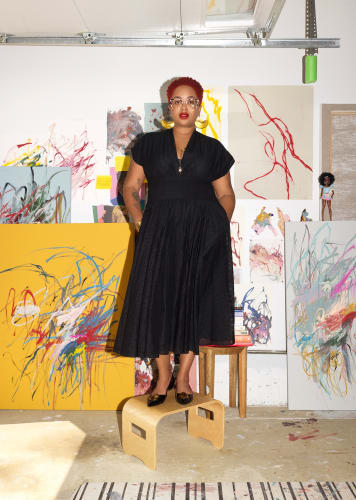The age of the Irascibles was all about the mind—minds so powerful they could create paintings that referenced nothing but themselves. That kind of solipsism is not particularly interesting now. Artists such as Rachel Jones, A’Driane Nieves, Li Hei Di, and Grace Carney see abstract painting as a place to express the power of not only the mind but also the body, spirit, and subconscious.
For the Texas-born, New Jersey–based artist A’Driane Nieves, painting is a way to process not society’s anxieties, but her own. After Nieves struggled with postpartum depression and bipolar disorder following the birth of her second son, her doctor suggested she pick up a paintbrush to keep her hands busy. “My therapist would tell me, ‘Trauma needs a way to move; it needs a place to go.’ Painting does that for me when I’m engaging my full body.” While pursuing a degree in social work after serving in the Air Force, Nieves gave herself a crash course in intuitive art making and Abstract Expressionism. She quickly found fans on Instagram and began devoting herself to art full-time in 2015. Three years later, she founded the Tessera Arts Collective, which promotes abstract work by female and nonbinary artists of color. Her first U.S. solo show, at the Los Angeles gallery Various Small Fires, is slated for February.
Nieves’s paintings look the way anxiety feels. Lines of color bounce to and fro across the surface of the canvas, getting tangled into knots like intrusive thoughts whizzing around in the mind. She starts her process by putting on headphones in her garage, which doubles as her studio. With Prince, Beyoncé, or Santigold in her ears, she begins dancing, tapping the canvas, and running her hands across its surface. It wasn’t until she saw one of her sons, who is neurodivergent, making similar movements that she identified her process as a form of stimming, a self-stimulating behavior common among those on the autism spectrum. Nieves maintains that if a new generation and demographic is given the opportunity, there will be endless corners of abstraction to explore. “You don’t know half of what can be expressed, communicated, or transformed through abstraction when it’s done by Black, Indigenous, queer, and Brown people,” she says.

